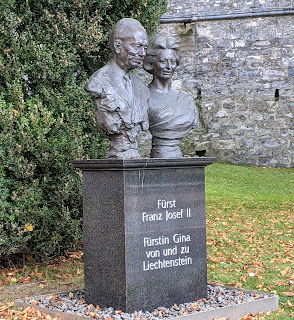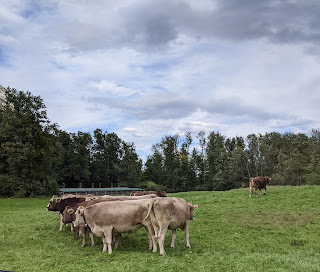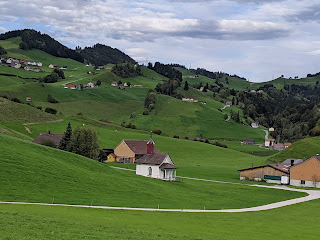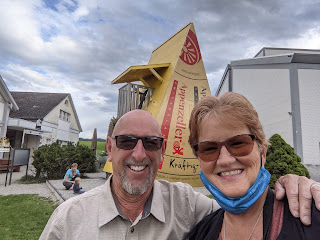Here are some photos of our apartment in the Zurich 'burbs though the word 'apartment' or even studio denotes someplace bigger than what we had. Zurich was incredibly expensive and this was certainly okay for three nights for us especially since it had a hot plate and free washer and dryer which is worth its weight in gold to travelers.
A roundabout en route to Vaduz, Liechtenstein, one of Europe's smallest countries that's popular for stamp collectors and if you're a 'country-collector' as I must admit to being. I'm pretty sure that Steven and I had traveled in excess of 100 countries and territories and thus were eligible to join the Travelers' Century Club.
We drove along a major highway that we'd hoped would be close to Zurichsee or Lake Zurich but turned out to be further inland. That was fine as we got a chance to see more of the countryside after taking a lake cruise the previous day and stopping at several small towns along the lake. Never did we think, though, that the superhighway would just be a few yards from farmland and so many cows. I could only guess space is such a premium in tiny Switzerland that every inch of arable land must be used even if it is close to major roads.
There were several tunnels we had to travel through on the 90-minute drive southeast toward Vaduz, the capital of Liechtenstein, our halfway point for the day. Being from Colorado, I like to think we have our fair share of tunnels through the Rocky Mountains but they were penny-ante compared to the number and length of those we traveled through in the land of Swiss Miss! One was over four miles long and I thought we'd never get to the end of it.
I wondered what people who lived so high up the mountains around Flums did, what sort of jobs they had there, what sort of lives they had. I chuckled seeing one sign that said Heidiland, I kid you not! The views were so cute, so picturesque, just like you'd imagine Switzerland as looking.
Steven was happy catching his first views of the Swiss mountains as that was the only reason why he wanted to visit the country.
High above the town was the Vaduz Castle still inhabited by the country's prince.
One of the more unusual license plates European travelers are ever likely to see are these black plated with the white 'FL' that stands for Furstentum Liechtenstein. The predominantly Catholic country is nestled between Switzerland and Austria with 'local' buses running back and forth between neighboring towns in all three countries!
Having seen so many sculptures by renowned Colombian sculptor Fernando Botero on one of our trips to South America, we immediately recognized the exaggerated size of this piece as one of his works.
Liechtenstein must be a draw for philatelists as there were stamp signs all over town.
If you read or just looked at the photos in my last post about our cruise on Zurichsee, you may recall the same tiny figures we encountered after getting off the boat in Rapperswil on the south end of the lake. Those were in royal blue, however. I've googled them trying to find out more about the cute figures but without success. If you can find out anything, please let me know as my interest is piqued!
The building housed the combined Postal Museum and Treasure Chamber. In the latter were the royal family’s treasures including hunting weapons, gifts offered to the royal family, and even a collection of Faberge eggs from the czar’s era.
We soon learned that the small capital of Vaduz had a number of modern art sculptures. This bronze one, by Gunther Stilling, was called African King.
If we had toured the National Museum, we would have learned about the country's history, archaeology, culture, etc, but we just didn't have that much interest and even less time.
We had to scoot out of the way when the little tourist train passed us on the pedestrian mall.
Also on the same pedestrian street was the almost cardboard-like building that was the country's new Parliament Building. There are just 25 representatives in the legislature. Both it and the square it was on were designed by the same architect and were constructed with the same golden-colored bricks in 2008. Neither was attractive in my eyes except they were harmonious if I am being positive.
A few steps away was the stately, old Parliament Building but now called Government House. It is used as the country's administrative center and it is where the state archives are kept.
Next to Government House was the Neo-Gothic St. Florin Cathedral that was built in 1874 on the site of earlier medieval foundations. Initially called the Liechtenstein Deanery, it was a part of the Swiss Diocese of Chur (a Swiss town) until Pope John Paul II declared it a cathedral in 1997. We tried entering the church not once but twice but, like the Fraumunster in Zurich, it was also closed each time.
In front of the church was a memorial bust honoring the first leaders of the country to actually maintain a residence in Liechtenstein, Prince Franz Josef II and Princess Gina. When he died in 1989, just four weeks after his wife, he had been the longest-ruling head of state in the world.
An unusual horse sculpture:
I loved how those little guys popped up everywhere!
Never had we come across such comfortable-looking chairs at a cafe before.
City Hall:
A view from small downtown Vaduz toward the castle; one of the few sights to see in the country:
More contortionist horses!
Steven and I wondered if this peculiar but handsome structure was a house, a museum, or what it was.
The regular path up to Vaduz Castle was closed but fortunately, we found another way up.
The hike was steep but easy and soon gave us panoramic views over the city and much of the country.
Along the path were half a dozen or more information panels about the country as I'm sure the powers that be figured they had a captive audience with foreigners all wanting to hike the path to the castle and banking on the fact that few people knew much of anything about Liechtenstein! We learned, for instance, that the principality was a constitutional hereditary monarchy and that at every step along the process laws require royal assent. Women were only given the right to vote in 1984.
Another information board indicated that evidence had shown the territory had been inhabited since the Neolithic Age in 3000 B.C. The County of Liechtenstein was created in 1342 through a division in the inheritance between brothers Rudolf and Hartmann of Wedenberg-Sargans. Then Liechtenstein Prince Johann Adam Andreas bought the Lordship of Schellenberg in 1699 and the County of Vaduz in 1712. Emperor Karl VI elevated both territories to become the Imperial Principality of Liechtenstein in 1719 but it was its own sovereign state in 1806.
Two-thirds of the country is occupied by hills and mountains with the highest point of 2,599 meters above sea level and the lowest just 430 meters. The flags represented the towns in Liechtenstein.
Some of the switchbacks on the steep trail up to the castle:
Liechtenstein's princes lived near Vienna until the 20th century as they viewed their country as a status symbol, declining even to visit. The image showed the "historical ducal coronet" of the Prince of Liechtenstein now Prince Hans-Adam II who was born in 1945. His eldest son, Prince Alois, has assumed some of the sovereign duties since 2004.
The first mention of Vaduz Castle was in documents from 1322 though its tower dates to the 12th century. After two towers were partially destroyed in the 1499 Swabian War, two round towers were added in the 16th century. After falling into disrepair, it was used as a barracks for the country's army, and then as a pub until 1896. Extensive renovations were carried out at the beginning of the 20th century. Since becoming the permanent residence of the ruling princes in 1938, the castle's 130 rooms have been closed to the public.
The shot through one set of gates showed the spectacular views the prince and his family enjoy at the top of the mountain.
Views of, and through, the other gate:
We could have climbed up even higher to see what looked like a chalet overlooking an orchard with trees heavy with apples.
I wondered how much of Liechtenstein we were gazing at as we headed down the trail!
Having driven along a good stretch of Route 66 earlier in the year, it was quite amusing seeing some fair rides in Vaduz called Route 66!
When we were at the tourist information center earlier, I had paid a few euros to have my passport stamped and to buy a few postcards although there was no reason except for its being a lark to have my passport stamped.
Another view of the castle but from the valley floor:
It took us a while to find the Old Bridge, the only remaining wooden bridge crossing the Rhine River. Built in 1901, the bridge connected Liechtenstein to Switzerland. The winds were incredibly strong so Steven decided to wait for me in the car while I slowly made my way to, and then across, the bridge.
Stepping foot again in windy Switzerland!
After driving north for a short while to see more of Liechtenstein, we crossed back over the Rhine into Switzerland at the tiny community of Haag.
I would have been interested in knowing the significance of the light bulb at the Swiss crossing!
Cowbell-clanging cows and a charming church greeted us at Sennwald.
Large, colored balls were along the road at Obierret - again, why?
Images that caught my eye en route to storybook-cute Appenzell:
Since leaving Switzerland about two weeks ago, I have so missed the reassuring sounds of the cowbells as they evoked a measure of peace and way of life so different than ours.
Another fun roundabout:
The country's and canton's flags made for a welcoming approach to what's been described as the authentically Swiss town of Appenzell.
The sign AND bottle advertised Appenzeller beer!
We decided to leave our visit of Appenzell to the next day and head directly to the nearby village of Stein to tour the well-known Appenzeller Dairy where the eponymous cheese is made.
Many Swiss believe(d) that the sound of bells banished all evil and that was why grazing cattle had bells hung around their necks. Cowherds and farmers nowadays say if the leading cow has a bell around its neck, it keeps the rest of the herd together; that the cowherd can hear when the cattle are becoming restless even at night; and young strays can more easily be found if they have bells on while grazing.
Thank goodness Steven was driving so I could take photos to my heart's content, even if they were mostly of cows and pastoral landscapes!
Normally, our timing happens to be uncommonly lucky but not that day as we arrived just as the dairy was closing for the day.
Others enjoyed traditional music while quaffing some beers.
I wonder what Wisconsin's cheeseheads might think of these cheese morsels!
Steven wasn't interested in joining me at the Stein Folk Museum, one of three in the area. I figured we had come a fair distance so at least one of us might as well make use of the time since the dairy was closed.
I read that a dairyman appeared on mountain pastures every week or two with his packhorse and carried the unmatured cheese to the dairy in the valley below.
As a cowherd's daily life and customs centered around his cows who were his pride and joy, the finest cows were decorated with magnificent bells. I would have loved to have known how much those bells weighed as some looked extremely heavy.
Belt making was a unique folk art of the Appenzell region and developed with trade merchants and their pack horses traveling around the hilly countryside which had almost no roads. The ornamental straps used for pack horses prompted farmers to decorate the cows' bell straps with engraved brass mountings near the end of the 18th century.
Since the 17th-century, finely painted beds, chests, and cupboards were traditional elements of a bride's trousseau.
There was quite a large collection of wall paintings that depicted the traditional Appenzeller style of naive alpine farming scenes. This type of art only developed around 200 years ago without the artists being concerned with the major artistic trends of their day.
Since Steven and I first came across work by an Amish watercolorist in Pennsylvania about 30 years ago, we have become very attracted to naive art. I would have bought one of these paintings in a heartbeat if I could.
Examples of traditional costumes through the ages:
Darlene: You would have enjoyed seeing the weaving cellar and satin stitch loom. The former would have been placed on the sunny side of the house next to the parlor and only long enough for the weaver to squeeze past the loom.
Swiss hand embroidery had its heyday in the 1840s and 1850s when it wasn't yet threatened by mechanization. As we traveled through the Alpine region, I was surprised how many shops sold exquisite hand-embroidered pieces as I didn't realize the Swiss were known for the craft.
The old schoolhouse in Stein dated from 1888.
Stein's Evangelical Reform Church:
Our room that night was in a century-old home in the village of Schonegrund. As it was so late in the season, we were the only guests in a room on what for us would be the third floor. As we were just staying one night, we just took a few things out of our bags so we didn't have to lug them up so many stairs. The Gasthaus oozed charm and was the antithesis of so many modern places we've stayed the world over.
Oozing charm also meant the wiring was a tad antiquated which we found out when trying to plug in an electric kettle which caused all the lights to blow a fuse! The older lady (perhaps not as old as we are but she seemed older!) wasn't fazed. thank goodness. The next morning, we had to take showers in the pitch black because there was again no power.
But the views out the lace-curtained windows were as pretty as it gets! We even nodded off to sleep to the sounds of cowbells - does life get any better!
Posted on October 26th, 2021, from a very, very chilly apartment on a country estate about ten country miles from Monteriggioni in Tuscany, Italy. What a tough life we lead is probably what you're thinking! Believe me, we constantly remind ourselves how lucky we are to travel at this time when so many people around the world are hurting because of Covid-19.












































































































































Oh how I love the pastoral scenes and mountain vistas of Switzerland ! Thanks for sharing ! xoxox
ReplyDeleteThanks, Lina, for the nice comment. I was obviously quite enamored with both the pastoral scenes and mountain vistas!
ReplyDeleteBeautiful! Thanks for sharing!
ReplyDeleteLoved the green pastures as we don't see them here in Colorado. Lovely view out your
ReplyDeleteSchonegrund overnight window. Janina
Sarah and Janina,
ReplyDeleteGlad you both liked the shots that were so typical of the Appenzell region of Switzerland. Hard to get a more idyllic scene than the one outside our window, right, Janina!